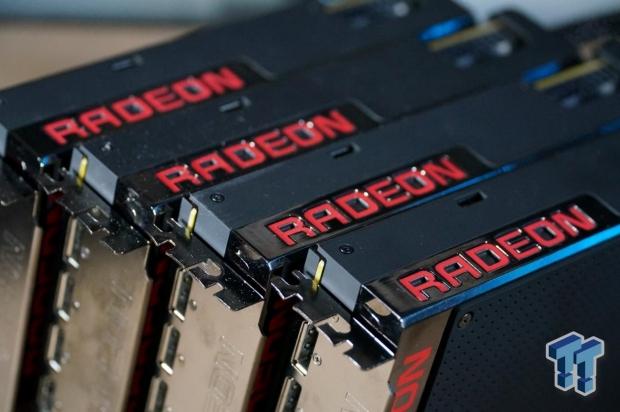Introduction & History Lesson on Fiji
It has been nearly 5 years since AMD released the Fiji GPU architecture, the first graphics card with HBM technology, and the flagship Radeon R9 Fury X. The company has almost shed its former skin since then and been completely reborn, almost like a Big Bang in itself.
In this testing, I wanted to cover graphics cards from years ago right through to the new Turing-based GeForce RTX 2000 series cards and the flagship GeForce RTX 2080 Ti and Radeon RX 5700 XT on the Navi architecture. I've included older-gen cards with the Maxwell-based GeForce GTX 900 series led by the GTX 980 Ti, as well as the Pascal architecture with GeForce GTX 1000 series cards and its flagship GTX 1080 Ti.
I've also included AMD's first RTG graphics card in the Radeon RX 400 series led by the Radeon RX 480 -- and their refreshes in the Radeon RX 580 and RX 590. Not just that, but the Radeon RX Vega 56 and Vega 64 -- as well as the first 7nm GPU in the Radeon VII and its 16GB of HBM2 memory.
I thought I would include as many graphics cards as I could from across multiple generations, so I've included:
- GeForce RTX 2080 Ti (11GB)
- GeForce RTX 2080 SUPER (8GB)
- GeForce RTX 2080 (8GB)
- GeForce RTX 2070 SUPER (8GB)
- GeForce RTX 2070 (8GB)
- GeForce RTX 2060 SUPER (8GB)
- GeForce RTX 2060 (6GB)
- MSI GTX 1660 Ti GAMING X (6GB)
- MSI GTX 1660 SUPER GAMING X (6GB)
- MSI GTX 1650 SUPER GAMING X (4GB)
- MSI GTX 1650 GAMING X (4GB)
- Radeon RX 5700 XT (8GB)
- Radeon RX 5700 (8GB)
- MSI RX 5600 XT GAMING X (8GB)
- MSI RX 5500 XT GAMING X (8GB)
- Radeon VII (16GB)
- Radeon RX Vega 64 LCE (8GB)
- Radeon RX Vega 64 AIR (8GB)
- Radeon RX Vega 56 AIR (8GB)
- Radeon R9 Fury X (4GB)
- MSI RX 590 MECH 2 (8GB)
- MSI RX 580 MECH 2 (8GB)
- MSI RX 570 MECH 2 (8GB)
- Radeon RX 480 (8GB)
- GeForce GTX 1080 Ti (11GB)
- GeForce GTX 1080 (8GB)
- GeForce GTX 1070Ti (8GB)
- GeForce GTX 1070 (8GB)
- GeForce GTX 1060 (6GB)
- GeForce GTX 980 Ti (6GB)
History Lesson on Fiji
History Lesson on Fiji -- The Last 5 Years of Radeon
We've seen AMD move away from its head-first dive into the world of High Bandwidth Memory (HBM), which it moved from Fiji to Vega and used HBM2, but then from Vega to Navi we saw the company shift to GDDR6 memory. This has been a big deal for the company, along with the huge change from the GCN (GraphicsCore Next) architecture to the RDNA architecture that powers Navi (and the PlayStation 5 and Xbox Series X consoles).
I exclusively reported back in June 2018 that AMD would be powering the next-gen Sony PlayStation 5 console with a semi-custom design based on the Zen CPU and Navi GPU architectures. AMD since then, has really turned things around -- but a history lesson up until that point is below.
AMD has since gone from having its CPU range go from 'not really bothering with, Intel is so much more superior' to 'uh yeah, so which Ryzen CPU did you buy this time'. Oh how life has changed for AMD -- now commanding over 50% of premium CPU sales worldwide, and it's not just Ryzen -- it's Threadripper and EPYC knocking down door after door at Intel.
Radeon on the other hand? This is where the idea for re-looking at the Radeon R9 Fury X (my review here) came from. It has been nearly 5 years to the day that AMD released the Radeon R9 Fury X -- and the world has changed (in so many other ways, too). NVIDIA has been completely dominant since 2015 -- hell, even more so.
NVIDIA has gone from stride to stride with its graphics card launches, no matter the hype and anger at pricing of the Turing-based GeForce RTX 2080 Ti (my review here). They flew off shelves because gamers were, and will always be, thirsty for the best of the best. AMD hasn't had a best of the best graphics card for a very long time -- and at the time, the Radeon R9 Fury X was meant to be just that -- the best of the best.
And we all know how that played out.
The Radeon R9 Fury X was a $649 mess, muddled with pre-installed AIO cooling because the card ran so hot -- and a million other issues. It was a good performer, but it didn't keep NVIDIA up at night either. NVIDIA responded, and kept responding, pushing AMD into Vega.
We all know how Vega went.
AMD released the Radeon RX Vega 56 and Radeon RX Vega 64 (my review here) and the launch was so-so at best. They weren't popular, and really only dominated in cryptocurrency mining. Which, at the time, was absolutely exploding. The crazy HBM2 tech on the Vega GPU was not really utilized well, and then GDDR5X and eventually GDDR6 came and knocked its doors down.
NVIDIA kept responding, and kept responding -- and kept pushing harder down on AMD until the company nailed the next-gen console contracts. The semi-custom design win allowed AMD to have flex some of its muscle with RDNA and the Navi GPU architecture. The shift to GDDR6 was a big win for graphics card fans and enthusiasts, as well as gamers -- as it will be the lifeblood of the next-gen consoles and the next few waves of graphics cards.
NVIDIA is already pushing the boundaries of near 20Gbps on current GDDR6 tech, and we should expect AMD to get far closer to that with RDNA2-based Navi 2X graphics cards later this year.
But at the time, AMD pushed and pushed that HBM was going to be the savior of everything -- and that HBCC would knock our socks off.
Once again, we all know how that went -- it was all marketing BS.
Or was it?
HBCC has no benefits to PC gamers outside of a few benchmarks and resolutions where it provides a few % more performance, but now we're seeing something very similar play out on next-gen consoles. The mix of PCIe 4.0 connectivity with a super-charged NVMe SSD and super-fast GDDR6 acting as huge chunks of ridiculously fast cache? That sounds like HBCC... or something at least close to it.
NVIDIA is also rumored to unveil something called NVCache, which sounds much like HBCC, with its next-gen Ampere GPU-based GeForce RTX 3080 Ti -- and other RTX 3000 series cards, later this year when it unveils the new family of graphics cards in September 2020.
AMD after that shed most of its Radeon Technologies Group team -- a team that was created to shield themselves from AMD as a whole. The team disbanded after Vega didn't make the waves it promised after Fiji (and the Radeon R9 Fury X that I'm about to look at today).
RTG disbanded and most of them went off to work with Intel -- the largest of which being GPU architect Raja Koduri -- and its new adventures into discrete GPUs with its new Xe architecture. Some of those folks eventually left AMD to work for other companies after a few months, and now we have a new team at AMD that hasn't really had the band together -- and won't get the chance because of COVID-19.
AMD will have a mystery release later this year for RDNA2 (more on that here) and its new, and what should eventuate in the Radeon RX 6000 series cards. My sources have told me there will be no media event for this release, the first time in over a decade (or more) that no media event will be held for a new family of graphics cards being released.
Without further ado, let's move into the rest of our re-look at the Radeon R9 Fury X graphics card and see how it keeps up in 2020.
Benchmarks - Synthetic
GPU Test Rig Specs
Welcome to the latest revision of our GPU test bed, with our system being upgraded from the Intel Core i7-7700K to the Core i7-8700K. The CPU is cooled by the Corsair H115i PRO cooler, with the 8700K overclocked to 5GHz. We've stayed with GIGABYTE for our motherboard with their awesome Z370 AORUS Gaming 7.
We approached our friends at HyperX for a kit of their kick ass HyperX Predator DDR4-2933MHz RAM (HX429C15PB3AK4/32), with 2 x 8GB sticks for a total of 16GB DDR4-2933. The RAM stands out through every minute of our testing as it has beautiful RGB lights giving the system a slick look while benchmarking our lives away, while the Z370 AORUS Gaming 7 motherboard joins in with its own array of RGB lighting.
Anthony's Test System Specifications
- Motherboard: GIGABYTE Z370 AORUS Gaming 7 (buy from Amazon)
- CPU: Intel Core i7-8700K @ 5GHz (buy from Amazon)
- Cooler: Corsair Hydro Series H115i PRO (buy from Amazon)
- Memory: 16GB (2x8GB) HyperX Predator DDR4-2933 (buy from Amazon)
- SSD: 1TB Toshiba OCZ RD400 NVMe M.2 (buy from Amazon)
- SSD: 512GB Toshiba OCZ RD400 NVMe M.2 (buy from Amazon)
- Power Supply: InWin 1065W
- Case: InWin X-Frame
- OS: Microsoft Windows 10 Pro 64-bit (buy from Amazon)
Additional Images
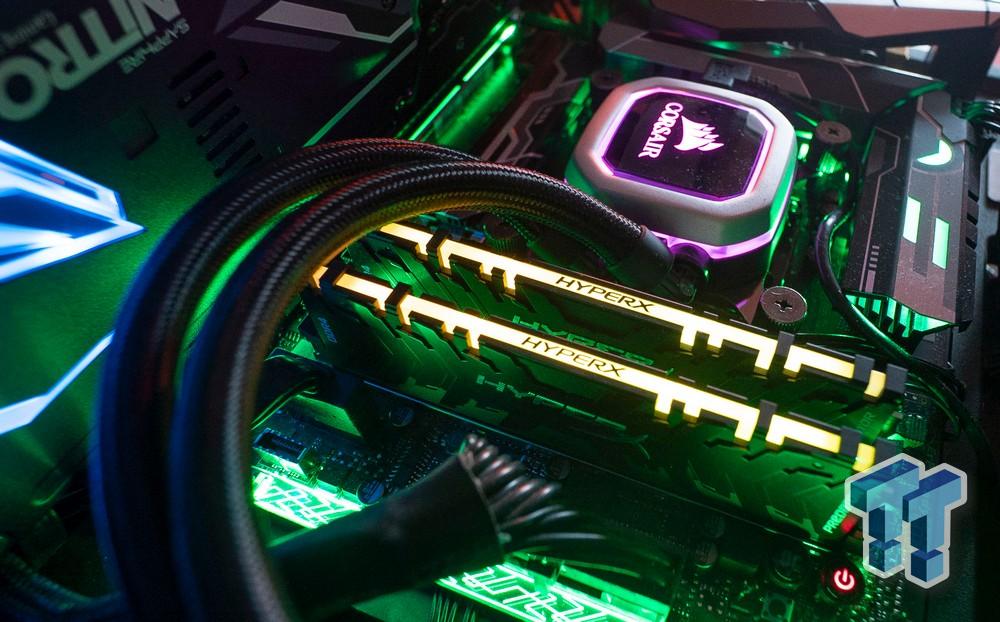
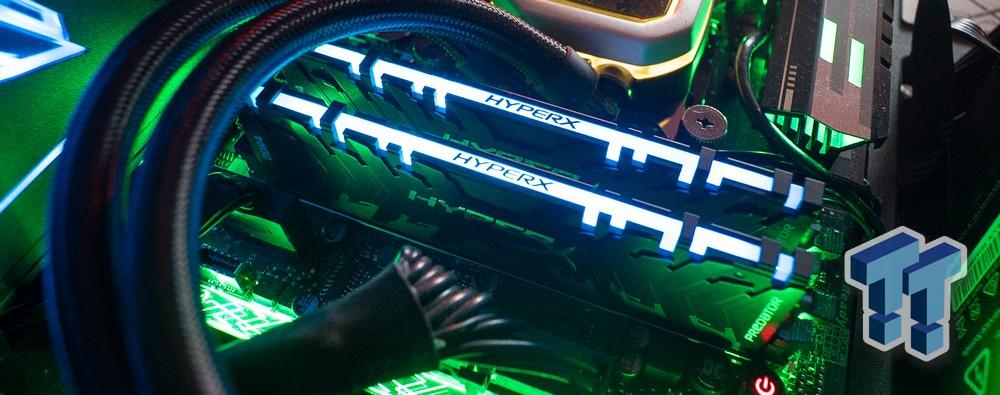
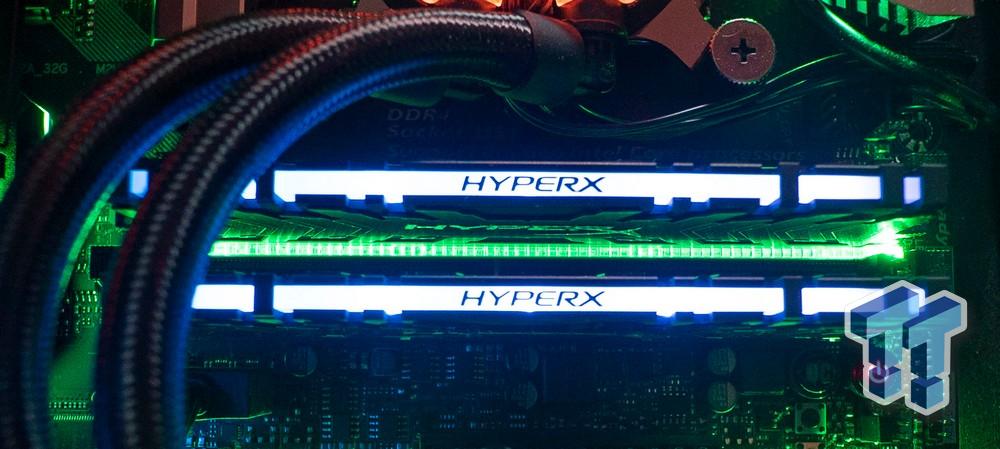
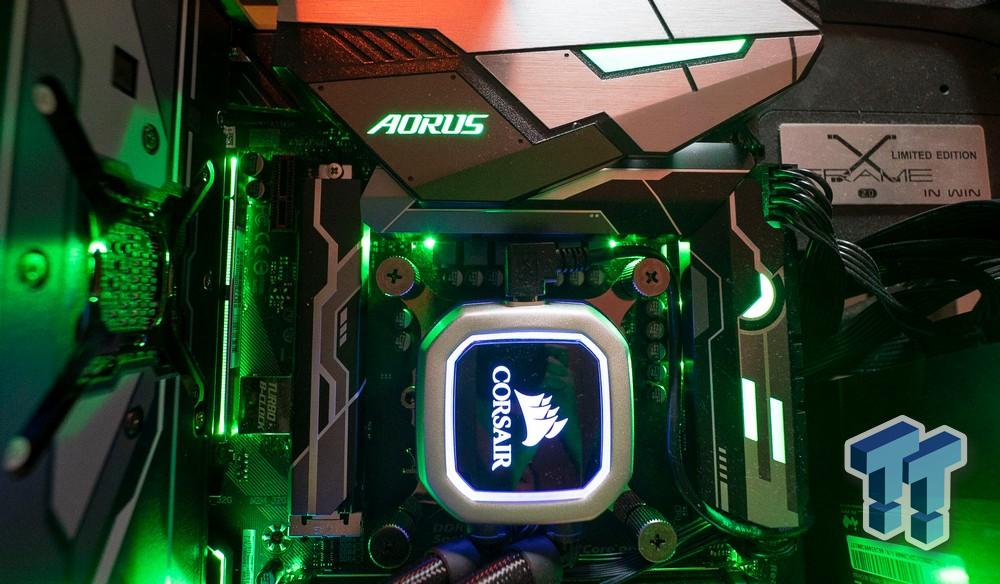
3DMark Fire Strike - 1080p
3DMark has been a staple benchmark for years now, all the way back to when The Matrix was released and Futuremark had bullet time inspired benchmarks. 3DMark is the perfect tool to see if your system - most important, your CPU and GPU - is performing as it should. You can search results for your GPU, to see if it falls in line with other systems based on similar hardware.
3DMark Fire Strike - 1440p
3DMark has been a staple benchmark for years now, all the way back to when The Matrix was released and Futuremark had bullet time inspired benchmarks. 3DMark is the perfect tool to see if your system - most important, your CPU and GPU - is performing as it should. You can search results for your GPU, to see if it falls in line with other systems based on similar hardware.
3DMark Fire Strike - 4K
3DMark has been a staple benchmark for years now, all the way back to when The Matrix was released and Futuremark had bullet time inspired benchmarks. 3DMark is the perfect tool to see if your system - most important, your CPU and GPU - is performing as it should. You can search results for your GPU, to see if it falls in line with other systems based on similar hardware.
3DMark TimeSpy
3DMark TimeSpy Extreme
Heaven - 1080p
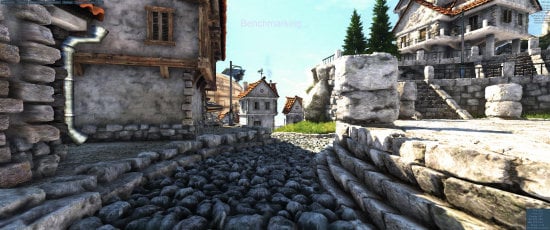
Heaven is an intensive GPU benchmark that really pushes your silicon to its limits. It's another favorite of ours as it has some great scaling for multi-GPU testing, and it's great for getting your GPU to 100% for power and noise testing.
Heaven - 1440p
Heaven - 4K
Benchmarks - 1080p
1080p Benchmarks
Middle-earth: Shadow of War is a sequel to the popular Shadow of Mordor, which was powered by the Lithtech engine. When cranked up to maximum detail, it will chew through your GPU and its VRAM like it's nothing.
You can buy Middle-earth: Shadow of War at Amazon.
Metro Exodus is one of the hardest tests that our graphics cards have to go through, with 4A Games' latest creation being one of the best looking games on the market. It is a serious test that pushes GPUs to their limits, and also features RTX technologies like DLSS.
Far Cry New Dawn was developed by Ubisoft, and is powered the Dunia Engine, an engine that has been modified over the years for Far Cry and last used in Far Cry 5. Dunia Engine itself was a modified version of CRYENGINE, scaling incredibly well on all sorts of hardware.
Shadow of the Tomb Raider is one of the latest games to join our graphics card benchmark lineup, with the game built using the Foundation engine as a base, the same engine in Rise of the Tomb Raider. Eidos Montreal R&D department made lots of changes to the engine during the development of Shadow of the Tomb Raider to make it one of the best-looking games out right now.
1080p Benchmark Performance Thoughts
We have some good performance at 1080p with the Radeon R9 Fury X in the VRAM intensive Middle-earth: Shadow of War, with 70FPS average -- but the Radeon RX 5500 XT comes in and knocks that down with its sub $200 kick ass performance with 89FPS average.
The gap disappears entirely at 1080p in Metro Exodus, with 40FPS flat for both the R9 Fury X and RX 5500 XT, as well as the RX 580 and GTX 980 Ti. 40FPS average is the flavor of the month for those cards.
Far Cry New Dawn sees the Radeon R9 Fury X tying with the GeForce GTX 1650 SUPER with 77FPS average, 2FPS up from the Radeon RX 580 and 5FPS slower than the Radeon RX 590.
Shadow of the Tomb Raider is an AMD friendly title, but the Radeon R9 Fury X falls behind here with 68FPS average, bringing it down to the same 68FPS average as the GeForce GTX 1060. The Radeon RX 5500 XT is miles away at 82FPS average.
Benchmarks - 1440p
1440p Benchmarks
Middle-earth: Shadow of War is a sequel to the popular Shadow of Mordor, which was powered by the Lithtech engine. When cranked up to maximum detail, it will chew through your GPU and its VRAM like it's nothing.
You can buy Middle-earth: Shadow of War at Amazon.
Metro Exodus is one of the hardest tests that our graphics cards have to go through, with 4A Games' latest creation being one of the best looking games on the market. It is a serious test that pushes GPUs to their limits, and also features RTX technologies like DLSS.
Far Cry New Dawn was developed by Ubisoft, and is powered the Dunia Engine, an engine that has been modified over the years for Far Cry and last used in Far Cry 5. Dunia Engine itself was a modified version of CRYENGINE, scaling incredibly well on all sorts of hardware.
Shadow of the Tomb Raider is one of the latest games to join our graphics card benchmark lineup, with the game built using the Foundation engine as a base, the same engine in Rise of the Tomb Raider. Eidos Montreal R&D department made lots of changes to the engine during the development of Shadow of the Tomb Raider to make it one of the best-looking games out right now.
1440p Benchmark Performance Thoughts
Starting with Shadow of War, the Radeon R9 Fury X barely beats the GeForce GTX 1650, and gets demolished by the Radeon RX 5500 XT -- we're looking at 51FPS average for the Fury X and 61FPS average for the RX 5500 XT. The Radeon RX 5700 XT for comparison, hits 91FPS here at 1440p in Shadow of War.
Metro Exodus is hard on any graphics card, with the Radeon R9 Fury X maintaining 33FPS average at 1440p -- identical results to the GeForce GTX 980 Ti, and 1FPS behind the Radeon RX 590.
Far Cry New Dawn nearly hits that magic 60FPS mark at 1440p on the Radeon R9 Fury X, failing to beat the RX 590 -- and keeps up better with the RX 5500 XT here but still loses to it.
We have just 48FPS at 1440p in Shadow of the Tomb Raider, losing to the RX 570 this time -- and getting its ass handed to it by the RX 5500 XT which achieves 56FPS average.
Benchmarks - 4K
4K Benchmarks
Middle-earth: Shadow of War is a sequel to the popular Shadow of Mordor, which was powered by the Lithtech engine. When cranked up to maximum detail, it will chew through your GPU and its VRAM like it's nothing.
You can buy Middle-earth: Shadow of War at Amazon.
Metro Exodus is one of the hardest tests that our graphics cards have to go through, with 4A Games' latest creation being one of the best looking games on the market. It is a serious test that pushes GPUs to their limits, and also features RTX technologies like DLSS.
Far Cry New Dawn was developed by Ubisoft, and is powered the Dunia Engine, an engine that has been modified over the years for Far Cry and last used in Far Cry 5. Dunia Engine itself was a modified version of CRYENGINE, scaling incredibly well on all sorts of hardware.
Shadow of the Tomb Raider is one of the latest games to join our graphics card benchmark lineup, with the game built using the Foundation engine as a base, the same engine in Rise of the Tomb Raider. Eidos Montreal R&D department made lots of changes to the engine during the development of Shadow of the Tomb Raider to make it one of the best-looking games out right now.
4K Benchmark Performance Thoughts
This is what I'm here for: 4K or 3840 x 2160.
AMD touted that its HBM and HBCC technologies would work wonders in high resolution gaming scenarios, so let's see how it holds up 5 years later.
Oh yeah -- it sucks.
Shadow of War? 33FPS average, beating out the Radeon RX 570/580/590 finally, but losing to the GTX 1070 and RX 5500 XT graphics cards. The Radeon RX 5700 XT on the other hand pushes out a much better 55FPS average.
The Radeon R9 Fury X gets it ass handed to it in Metro Exodus, where it is only capable of 15FPS at 4K. It matches the Radeon RX 480 (hah) but loses to every single Radeon RX 500 series card (haha). The Radeon RX 5500 XT has 20FPS here, while the flagship Navi-based Radeon RX 5700 XT pushes ahead with 33FPS average.
Far Cry New Dawn is still hardcore on the R9 Fury X, which manages just 26FPS average at 4K -- identical to the RX 570, and 3FPS behind the RX 580. Shadow of the Tomb Raider is just 1FPS off of 30FPS, this time matching the RX 5500 XT for once.
Benchmarks - Synthetic (Radeon Only)
GPU Test Rig Specs
Welcome to the latest revision of our GPU test bed, with our system being upgraded from the Intel Core i7-7700K to the Core i7-8700K. The CPU is cooled by the Corsair H115i PRO cooler, with the 8700K overclocked to 5GHz. We've stayed with GIGABYTE for our motherboard with their awesome Z370 AORUS Gaming 7.
We approached our friends at HyperX for a kit of their kick ass HyperX Predator DDR4-2933MHz RAM (HX429C15PB3AK4/32), with 2 x 8GB sticks for a total of 16GB DDR4-2933. The RAM stands out through every minute of our testing as it has beautiful RGB lights giving the system a slick look while benchmarking our lives away, while the Z370 AORUS Gaming 7 motherboard joins in with its own array of RGB lighting.
Anthony's Test System Specifications
- Motherboard: GIGABYTE Z370 AORUS Gaming 7 (buy from Amazon)
- CPU: Intel Core i7-8700K @ 5GHz (buy from Amazon)
- Cooler: Corsair Hydro Series H115i PRO (buy from Amazon)
- Memory: 16GB (2x8GB) HyperX Predator DDR4-2933 (buy from Amazon)
- SSD: 1TB Toshiba OCZ RD400 NVMe M.2 (buy from Amazon)
- SSD: 512GB Toshiba OCZ RD400 NVMe M.2 (buy from Amazon)
- Power Supply: InWin 1065W
- Case: InWin X-Frame
- OS: Microsoft Windows 10 Pro 64-bit (buy from Amazon)
Additional Images




3DMark Fire Strike - 1080p
3DMark has been a staple benchmark for years now, all the way back to when The Matrix was released and Futuremark had bullet time inspired benchmarks. 3DMark is the perfect tool to see if your system - most important, your CPU and GPU - is performing as it should. You can search results for your GPU, to see if it falls in line with other systems based on similar hardware.
3DMark Fire Strike - 1440p
3DMark has been a staple benchmark for years now, all the way back to when The Matrix was released and Futuremark had bullet time inspired benchmarks. 3DMark is the perfect tool to see if your system - most important, your CPU and GPU - is performing as it should. You can search results for your GPU, to see if it falls in line with other systems based on similar hardware.
3DMark Fire Strike - 4K
3DMark has been a staple benchmark for years now, all the way back to when The Matrix was released and Futuremark had bullet time inspired benchmarks. 3DMark is the perfect tool to see if your system - most important, your CPU and GPU - is performing as it should. You can search results for your GPU, to see if it falls in line with other systems based on similar hardware.
3DMark TimeSpy
3DMark TimeSpy Extreme
Heaven - 1080p

Heaven is an intensive GPU benchmark that really pushes your silicon to its limits. It's another favorite of ours as it has some great scaling for multi-GPU testing, and it's great for getting your GPU to 100% for power and noise testing.
Heaven - 1440p
Heaven - 4K
Benchmarks - 1080p (Radeon Only)
1080p Benchmarks
Middle-earth: Shadow of War is a sequel to the popular Shadow of Mordor, which was powered by the Lithtech engine. When cranked up to maximum detail, it will chew through your GPU and its VRAM like it's nothing.
You can buy Middle-earth: Shadow of War at Amazon.
Metro Exodus is one of the hardest tests that our graphics cards have to go through, with 4A Games' latest creation being one of the best looking games on the market. It is a serious test that pushes GPUs to their limits, and also features RTX technologies like DLSS.
Far Cry New Dawn was developed by Ubisoft, and is powered the Dunia Engine, an engine that has been modified over the years for Far Cry and last used in Far Cry 5. Dunia Engine itself was a modified version of CRYENGINE, scaling incredibly well on all sorts of hardware.
Shadow of the Tomb Raider is one of the latest games to join our graphics card benchmark lineup, with the game built using the Foundation engine as a base, the same engine in Rise of the Tomb Raider. Eidos Montreal R&D department made lots of changes to the engine during the development of Shadow of the Tomb Raider to make it one of the best-looking games out right now.
1080p Benchmark Performance Thoughts
I decided to spend many more hours on benchmark charts for you guys, so I could illustrate in the previous pages how the Radeon R9 Fury X stacks up against ALL of the graphics cards -- but in these charts, I've used only AMD Radeon graphics cards to see how the Fury X stacks up against its own Radeon brethren.
Starting with Shadow of War at 1080p we see the higher memory bandwidth of the HBM2-based Radeon RX Vega 56 and Vega 64 as well as the Radeon VII pulling way far and out from the Fury X. The faster GDDR6 memory on the Navi-based Radeon RX 5000 series cards see it soar ahead of the HBM(1) on the Fury X.
The same goes for Metro Exodus, where the HBM2/GDDR6 based Radeon cards pull way ahead -- the previous-gen and HBM1-based cards are stuck at 44FPS and below here at 1080p.
Far Cry New Dawn is a little more forgiving, but we still see the Radeon R9 Fury X falling in between the Radeon RX 500 series cards. But wow-oh-wow, in Shadow of the Tomb Raider (which is an AMD friendly game) smacks the R9 Fury X all over the place -- it is the second slowest Radeon in the stack losing to the Radeon RX 480.
Benchmarks - 1440p (Radeon Only)
1440p Benchmarks
Middle-earth: Shadow of War is a sequel to the popular Shadow of Mordor, which was powered by the Lithtech engine. When cranked up to maximum detail, it will chew through your GPU and its VRAM like it's nothing.
You can buy Middle-earth: Shadow of War at Amazon.
Metro Exodus is one of the hardest tests that our graphics cards have to go through, with 4A Games' latest creation being one of the best looking games on the market. It is a serious test that pushes GPUs to their limits, and also features RTX technologies like DLSS.
Far Cry New Dawn was developed by Ubisoft, and is powered the Dunia Engine, an engine that has been modified over the years for Far Cry and last used in Far Cry 5. Dunia Engine itself was a modified version of CRYENGINE, scaling incredibly well on all sorts of hardware.
Shadow of the Tomb Raider is one of the latest games to join our graphics card benchmark lineup, with the game built using the Foundation engine as a base, the same engine in Rise of the Tomb Raider. Eidos Montreal R&D department made lots of changes to the engine during the development of Shadow of the Tomb Raider to make it one of the best-looking games out right now.
1440p Benchmark Performance Thoughts
I decided to spend many more hours on benchmark charts for you guys, so I could illustrate in the previous pages how the Radeon R9 Fury X stacks up against ALL of the graphics cards -- but in these charts, I've used only AMD Radeon graphics cards to see how the Fury X stacks up against its own Radeon brethren.
We should see the Radeon R9 Fury X scale up and take some wins the higher the resolution we go, with Shadow of War seeing the Fury X beating out the Radeon RX 480, RX 570, RX 580, and RX 590. It loses still to the new GDDR6-packed Radeon RX 5500 XT by 10FPS at 1440p.
Metro Exodus sees similar drops, with the Fury X falling under the Radeon RX 590, with 33FPS average -- losing by 1FPS to the RX 590. The Radeon RX 5500 XT actually loses to the Fury X here -- but by a single frame per second.
Far Cry New Dawn sees AMD's Radeon R9 Fury X being the fourth-slowest card in the AMD Radeon cards, with the Radeon RX 5500 XT being 3FPS faster at 1440p. The AMD-friendly Shadow of the Tomb Raider has the Fury X falling off a cliff down to 48FPS average, just 5FPS better than the RX 480 -- and 8FPS slower than the RX 5500 XT.
Benchmarks - 4K (Radeon Only)
4K Benchmarks
Middle-earth: Shadow of War is a sequel to the popular Shadow of Mordor, which was powered by the Lithtech engine. When cranked up to maximum detail, it will chew through your GPU and its VRAM like it's nothing.
You can buy Middle-earth: Shadow of War at Amazon.
Metro Exodus is one of the hardest tests that our graphics cards have to go through, with 4A Games' latest creation being one of the best looking games on the market. It is a serious test that pushes GPUs to their limits, and also features RTX technologies like DLSS.
Far Cry New Dawn was developed by Ubisoft, and is powered the Dunia Engine, an engine that has been modified over the years for Far Cry and last used in Far Cry 5. Dunia Engine itself was a modified version of CRYENGINE, scaling incredibly well on all sorts of hardware.
Shadow of the Tomb Raider is one of the latest games to join our graphics card benchmark lineup, with the game built using the Foundation engine as a base, the same engine in Rise of the Tomb Raider. Eidos Montreal R&D department made lots of changes to the engine during the development of Shadow of the Tomb Raider to make it one of the best-looking games out right now.
4K Benchmark Performance Thoughts
I decided to spend many more hours on benchmark charts for you guys, so I could illustrate in the previous pages how the Radeon R9 Fury X stacks up against ALL of the graphics cards -- but in these charts, I've used only AMD Radeon graphics cards to see how the Fury X stacks up against its own Radeon brethren.
Alright, we're at the business end of the benchmarks now -- with the Radeon R9 Fury X hitting 33FPS in Shadow of War at 4K, beating the lower-end Radeon RX 500 series cards but losing to the Radeon RX 5500 XT at 36FPS.
Metro Exodus punishes everything you throw at it, with the Fury X tripping over itself to even provide 15FPS at 4K -- the same result as the RX 480 -- and 5FPS slower than the Radeon RX 5500 XT.
Far Cry New Dawn isn't much better, with the Radeon R9 Fury X achieving 26FPS -- the same as the RX 570 and 1FPS better than the RX 480. It loses to the RX 580 with 29FPS, and to the RX 5500 XT with 31FPS.
Things are a tiny bit better for the Fury X in Shadow of the Tomb Raider, with 29FPS at 4K -- this time the R9 Fury X matches the RX 5500 XT but loses to the RX 580 and RX 590 graphics cards.
Temps & Power
Temperatures
You'd be surprised: Fury X runs pretty damn cool at just 58C. It's the coolest card on my charts next to the just-reviewed ASUS TUF Gaming X3 OC Radeon RX 5700 graphics card with its revised thermal solution. You can read the full review on that here.
But damn, 58C.
AMD's Radeon R9 Fury X might not win performance crowns, but it wins the thermal performance here. Remember, it does have a huge AIO cooler and I'm not a fan (if you'll pardon the pun) of that. I'd rather an air-cooled card for convenience, but the thermal performance here is warranted -- 58C is a stellar achievement.
Power Consumption
It's not overly power hungry, but it still sees my Intel Core i7-8700K test bed chewing up to 300W under load. This puts it above the Radeon RX 5700 XT reference card, and just under an overclocked Radeon RX 5700 XT -- but with far less performance.
Final Thoughts
So there you have it -- another look at AMD's Radeon R9 Fury X that launched 5 years ago now. How does it perform? It is alright, nothing surprising -- it hasn't aged well in a world of mid-range cards that not only keep up performance wise, but also offer that important increase in frame buffer with 8GB of VRAM.
AMD launched the Radeon R9 Fury X in a world where 4K gaming was only just becoming a thing, and high refresh rate 1080p and 1440 monitors were launching. Well, now we live in a world where those are aplenty, and even 4K 120Hz and above displays are now a reality.
HBM might have been a technological marvel at the time, and HBCC was pretty much marketing fluff -- but from a technological perspective I still admire what AMD was able to achieve with the Radeon R9 Fury X. The first graphics card with HBM memory, and it was an impressive feat.
But even that fan-dangled HBM technology isn't enough when even at 1080p the Fury X gets smashed by mid-range cards like the Radeon RX 590 and GeForce GTX 1070. Hell, the new Radeon RX 5500 XT is superior in virtually every single test. That goes to show how far AMD has come architecturally from Fiji to Navi.
AMD has come a very long way with its GPU architectures since 2015, leading right up into 2019 when it launched its new Navi GPU architecture and the flagship Radeon RX 5700 XT. The RX 5700 XT blows the R9 Fury X out of the water, with Navi being so much better in so many ways that even the lowest end member of the RX 5000 series family beats the Fury X.
The Radeon RX 5500 XT launched at $199 with 8GB of RAM and it beats the Radeon R9 Fury X which launched at $649 with 4GB of RAM. AMD has come a very long way when it comes to giving gamers some kick ass value for money, and the Radeon RX 5500 XT shows just how far the company has come.
- 2015 -- Fiji GPU + 4GB HBM2 = $649
- 2020 -- Navi GPU + 8GB GDDR6 = $199
All this does for me is make me want to see what RDNA 2 turns out to be like, and these retrospective looks are always fun. The next one in line will be another look at the Radeon RX Vega 64 Liquid Cooled Edition -- which is another fun release from AMD.

